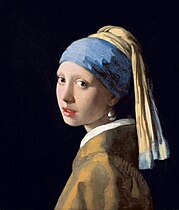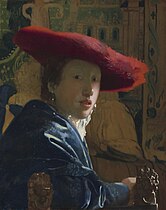Johannes Vermeer
Johannes Vermeer | |
|---|---|
Catharina Bolnes | |
| Signature | |
 |
Johannes Vermeer (
Vermeer worked slowly and with great care, and frequently used very expensive
The modest celebrity he enjoyed during his life gave way to obscurity after his death. He was barely mentioned in Arnold Houbraken's major source book on 17th-century Dutch painting (Grand Theatre of Dutch Painters and Women Artists, published 1718) and, as a result, was omitted from subsequent surveys of Dutch art for nearly two centuries.[7][a] In the 19th century, Vermeer was rediscovered by Gustav Friedrich Waagen and Théophile Thoré-Bürger, who published an essay attributing 66 pictures to him, although only 34 paintings are universally attributed to him today.[2] Since that time, Vermeer's reputation has grown enormously.
Pronunciation of name
In Dutch, Vermeer is pronounced [vərˈmeːr], and Johannes Vermeer as [joːˈɦɑnəs fərˈmeːr], with /v/ assimilating to the preceding voiceless /s/ as [f]. The usual English pronunciation is /vərˈmɪər/, with /vɜːrˈmɪər/, with a long first vowel, occurring in the UK.[9][10][11] /vərˈmɛər/ is also documented.[9][10][12][13] Another pronunciation, /vɛərˈmɪər/, is attested from the UK.[14]
Life


Relatively little was known about Vermeer's life until recently.[15] He seems to have been devoted exclusively to his art, living out his life in the city of Delft. Until the 19th century, the only sources of information were a few registers, official documents, and comments by other artists; for this reason, Thoré-Bürger named him "The Sphinx of Delft".[16] John Michael Montias added details on the family from the city archives of Delft in his Artists and Artisans in Delft: A Socio-Economic Study of the Seventeenth Century (1982).
Youth and heritage
Johannes Vermeer was
Marriage and family
In April 1653, Johannes Reijniersz Vermeer married a
Career

It is unclear where and with whom Vermeer apprenticed as a painter. There is some speculation that
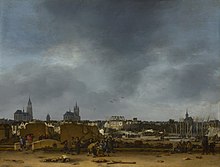
On 29 December 1653, Vermeer became a member of the
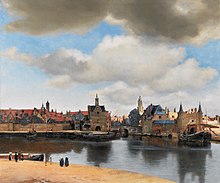
The influence of Johannes Vermeer on Metsu is unmistakable: the light from the left, the marble floor.
In 1671,
Wars and death

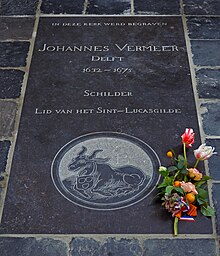
In 1672, a severe economic downturn (the "Year of Disaster") struck the Netherlands, after Louis XIV and a French army invaded the Dutch Republic from the south (known as the Franco-Dutch War). During the Third Anglo-Dutch War, an English fleet attacked by sea, and two allied German bishops invaded the country from the east, causing more destruction. Many people panicked; courts, theaters, shops and schools were closed. Vermeer's sale of a painting[clarify] that year was his last.[29] Five years passed before circumstances improved. In 1674, Vermeer was listed as a member of the civic guards.[45] In the summer of 1675, Vermeer borrowed 1,000 guilders in Amsterdam from Jacob Romboutsz (grandfather of Hendrick Sorgh), an Amsterdam silk trader, using his mother-in-law's property as a surety.[46][47]
On 15 December 1675, Vermeer died after a short illness aged 43. He was buried in the Protestant Old Church on 15 December 1675.[l][m] In a petition to her creditors, Catharina Bolnes attributed her husband's death to the stress of financial pressures, and described his death as follows:
...during the ruinous war with France he not only was unable to sell any of his art but also, to his great detriment, was left sitting with the paintings of other masters that he was dealing in. As a result and owing to the great burden of his children having no means of his own, he lapsed into such decay and decadence, which he had so taken to heart that, as if he had fallen into a frenzy, in a day and a half he went from being healthy to being dead.[48]
Catharina describes how the collapse of the art market had damaged Vermeer's business as both a painter and an art dealer. She had to raise 11 children and therefore asked the High Court to relieve her of debts owed to Vermeer's creditors.[32] Pioneering Dutch microscopist Antonie van Leeuwenhoek, who worked for the city council as a surveyor, was appointed trustee.[49] The house had eight rooms on the first floor, the contents of which were listed in an inventory taken a few months after Vermeer's death.[50] In his studio, there were two chairs, two painter's easels, three palettes, 10 canvases, a desk, an oak pull table, a small wooden cupboard with drawers, and "rummage not worthy being itemized".[51] Nineteen of Vermeer's paintings were bequeathed to Catharina and her mother. The widow sold two more paintings to Hendrick van Buyten to pay off a substantial debt.[52]
Vermeer had been a respected artist in Delft, but he was almost unknown outside his hometown. A local patron named Pieter van Ruijven had purchased much of his output, which kept Vermeer afloat financially but reduced the possibility of his fame spreading.[n] Several factors contributed to his limited body of work. Vermeer never had any pupils, though one scholar has suggested that Vermeer taught his eldest daughter Maria to paint.[53] Additionally, his family obligations with so many children may have taken up much of his time, as would acting as both an art dealer and inn-keeper in running the family businesses. His time spent serving as head of the guild and his extraordinary precision as a painter may have also limited his output.
Style

Vermeer may have first executed his paintings tonally like most painters of his time, using either monochrome shades of grey ("grisaille") or a limited palette of browns and greys ("dead coloring"), over which he would apply more saturated colors (reds, yellows and blues) in the form of transparent glazes. No drawings have been positively attributed to Vermeer, and his paintings offer few clues to preparatory methods.
There is no other 17th-century artist who employed the exorbitantly expensive pigment ultramarine (derived from natural lapis lazuli) either so lavishly or so early in his career. Vermeer used this in not just elements that are naturally of this colour; he also used it early in a work, beneath subsequent earth colours such as umber and ochre, to subtly tint their shade.[54] This working method most probably was inspired by Vermeer's understanding of Leonardo's observations that the surface of every object partakes of the colour of the adjacent object.[55]
An example of Vermeer using ultramarine as an underpaint is in The Girl with the Wine Glass. The shadows of the red satin dress are underpainted in natural ultramarine,[56] and, owing to this underlying blue paint layer, the red lake and vermilion mixture applied over it acquires a slightly purple, cool and crisp appearance.
Even after Vermeer's evident financial breakdown following the so-called rampjaar (year of disaster) in 1672, he continued to employ natural ultramarine generously, such as in Lady Seated at a Virginal. This could suggest that Vermeer was supplied with materials by a collector, and would coincide with John Michael Montias' theory that Pieter van Ruijven was Vermeer's patron.
Vermeer's works are largely
Painting materials
One aspect of his meticulous painting technique was Vermeer's choice of pigments.
In Vermeer's oeuvre, only about 20 pigments have been detected. Of these, seven principal pigments that Vermeer commonly employed are lead white, yellow ochre, vermilion, madder lake, green earth, raw umber, and ivory or bone black.[61]
Theories of mechanical aid
Vermeer's painting techniques have long been a source of debate, given their almost
In 2001, British artist David Hockney published the book Secret Knowledge: Rediscovering the Lost Techniques of the Old Masters, in which he argued that Vermeer (among other Renaissance and Baroque artists including Hans Holbein and Diego Velázquez) used optics to achieve precise positioning in their compositions, and specifically some combination of curved mirrors, camera obscura, and camera lucida. This became known as the Hockney–Falco thesis, named after Hockney and Charles M. Falco, another proponent of the theory.
Philip Steadman published the book Vermeer's Camera: Uncovering the Truth behind the Masterpieces in 2001 which specifically claimed that Vermeer had used a camera obscura to create his paintings. Steadman noted that many of Vermeer's paintings had been painted in the same room, and he found six of his paintings that are precisely the right size if they had been painted from inside a camera obscura in the room's back wall.[63]
Supporters of these theories have pointed to evidence in some of Vermeer's paintings, such as the often-discussed sparkling pearly highlights in Vermeer's paintings, which they argue are the result of the primitive lens of a camera obscura producing halation. It was also postulated that a camera obscura was the mechanical cause of the "exaggerated" perspective seen in The Music Lesson (London, Royal Collection).[64]
In 2008, American entrepreneur and inventor
Several points were brought out by Jenison in support of this technique: first was Vermeer's hyper-accurate rendition of light falloff along the wall. Neurobiologist Colin Blakemore, in an interview with Jenison, notes that human vision cannot process information about the absolute brightness of a scene.[66] Another was the addition of several highlights and outlines consistent with matching the effects of chromatic aberration, particularly noticeable in primitive optics. Last, and perhaps most telling, is a noticeable curvature in the original painting's rendition of the scrollwork on the virginal. This effect matched Jenison's technique precisely, caused by exactly duplicating the view as seen from a curved mirror.
This theory remains disputed. There is no historical evidence regarding Vermeer's interest in optics, and the detailed inventory of the artist's belongings drawn up after his death includes no camera obscura or any similar device.[67][50][o] However, Vermeer was in close connection with pioneer lens maker Antonie van Leeuwenhoek, who was his executor after death.[69]
Works
It is believed Vermeer produced a total of fewer than 50 paintings, of which 34 have survived.[70] Only three Vermeer paintings were dated by the artist: The Procuress (1656; Gemäldegalerie, Dresden); The Astronomer (1668; Musée du Louvre, Paris); and The Geographer (1669; Städelsches Kunstinstitut, Frankfurt).
Vermeer's mother-in-law Maria Thins owned
A few of his paintings show a certain hardening of manner and are generally thought to represent his late works. From this period come The Allegory of Faith (c. 1670; Metropolitan Museum of Art, New York) and The Love Letter (c. 1670; Rijksmuseum, Amsterdam).
Legacy

Originally, Vermeer's works were largely overlooked by art historians for two centuries after his death. A select number of connoisseurs in the Netherlands did appreciate his work, yet even so, many of his works were attributed to then better-known artists such as
Upon the rediscovery of Vermeer's work, several prominent Dutch artists modelled their style on his work, including
Han van Meegeren was a 20th-century Dutch painter who worked in the classical tradition. He became a master forger, motivated by a blend of aesthetic and financial reasons, creating and selling many new "Vermeers" before turning himself in for forgery to avoid being charged with capital treason for collaboration with the Nazis, specifically, in selling what had been believed to be original artwork to the Nazis.[78]
On the evening of 23 September 1971, a 21-year-old hotel waiter, Mario Pierre Roymans, stole Vermeer's Love Letter from the Fine Arts Palace in Brussels where it was on loan from the Rijksmuseum for the exhibition Rembrandt and his Age.[79]
To mark the 26th anniversary of the opening of an exhibition at Washington, DC's National Gallery of Art featuring his work, Google honored Vermeer with a Google Doodle on 12 November 2021.[80]
A 2023 exhibition at the Rijksmuseum in Amsterdam featured 28 of his works, the most ever shown together.[81] Over 650,000 people visited the exhibition, making it the museum's most visited exhibition.[82] Coinciding with the 2023 exhibition the documentary film Close to Vermeer was released the same year. The film followed curators Gregor J. M. Weber and Pieter Roelofs as they sought loans of Vermeer's artwork from museums around the world.[83] Also released in 2023 was another movie about the exhibition at the Rijkmuseum: "Vermeer: The Greatest Exhibition". (External links to both movies are below.)
In popular culture
Vermeer's reputation and works have been featured in both literature and in films. Tracy Chevalier's novel Girl with a Pearl Earring (1999), and the 2003 film of the same name, present a fictional account of Vermeer's creation of the famous painting and his relationship with the equally fictional model.
Many artists are inspired by the famous painter, for example, culinary photographer Aimee Twigger draws on Vermeer's chiaroscuro for her gustatory journeys through recipes.[84]
Gallery of selected works
-
The Girl with the Wine Glass (c. 1659), Herzog Anton Ulrich Museum in Brunswick, Germany
-
The Music Lesson or A Lady at the Virginals with a Gentleman (c. 1662–1665), Royal Collection in London
-
Girl with a Pearl Earring (1665), considered a Vermeer masterpiece, Mauritshuis in Den Haag
-
Girl with the Red Hat (c. 1665–1666), National Gallery of Art in Washington, D.C.
-
Mistress and Maid (1666–67), Frick Collection in New York City
-
The Art of Painting or The Allegory of Painting (c. 1666–1668), Kunsthistorisches Museumin Vienna
-
Musée du Louvrein Paris
-
Städel Museumin Frankfurt am Main
-
Lady Writing a Letter with her Maid (c. 1670–71), National Gallery of Ireland in Dublin, Ireland
-
The Allegory of Faith (1670–1672), Metropolitan Museum of Art in New York
-
Lady Seated at a Virginal (c. 1670–1672), National Gallery in London
Notes
- ^ Vermeer was largely unknown to the general public, but his reputation was not totally eclipsed after his death: "While it is true that he did not achieve widespread fame until the 19th century, his work had always been valued and admired by well-informed connoisseurs."[8]
- ^ Vermeer was baptized as Joannis.[19][17] Jan was the most popular version of the name among Calvinists. Joannis was a Latinazied form of Jan, which was preferred by Roman Catholics and upper-middle class Protestants.[19][17] However, Vermeer was born into a lower-middle class family.[20][21] Still, according to Montias, it is unlikely that his parents were Catholics "at this time [the time of Vermeer's baptism]," seeing that they "baptized him in the established church."[19] Throughout his life, Vermeer never used the name Jan. Nevertheless, "most Dutch authors, in the century since his rediscovery, have dubbed him Jan, perhaps unconsciously to bring him closer to the mainstream of Calvinist culture."[19][17]
- ^ His mother was born in Antwerp. When she married Vermeer's father in 1615, she claimed to be twenty years old, but she may have "exaggerated her age by a year or so."[23] Digna's parents were married in Antwerp in 1596.
- patronym. As there was another Reijnier Jansz at that time in Delft, it seemed necessary to use the pseudonym "Vos", meaning Fox. From 1640 onward, he had changed his alias to Vermeer.
- ^ Neeltge remarried three times, the second time shortly after Jan's death, in October 1597.[25]
- ^ In 1647 Geertruy, Vermeer's only sister, married a frame maker. She kept on working at the inn helping her parents, serving drinks and making beds.
- Schuilkerk). Catholics were restrained in their careers, unable to get high-rank jobs in city administration or civic guard. It was impossible to be elected as a member of the city council; therefore, the Catholics were not represented in the provincial and national assembly.
- ^ A Roman Catholic chapel now exists at this spot.
- ^ The parish registers of the Delft Catholic church do not exist anymore, so it is impossible to prove but likely that his children were baptized in a hidden church.
- ^ The number of children seems inconsistent, but 11 was stated by his widow in a document to get help from the city council. One child died after this document was written.
- ^ Identifiable works include compositions by Utrecht painters Baburen and Everdingen.
- ^ He was baptized as Joannis, but buried under the name Jan.[relevant?]
- ^ When Catharina Bolnes was buried in 1688, she was registered as the "widow of Johan Vermeer".
- ^ Van Ruijven's son-in-law Jacob Dissius owned 21 paintings by Vermeer, listed in his heritage in 1695. These paintings were sold in Amsterdam the following year in a much-studied auction, published by Gerard Hoet.
- ^ The inventory taken soon after Vermeer's death does not mention a camera obscura, although it does include easels, palettes, canvases, and a possible maulstick. Gold, silver, jewellery, or musical instruments are not mentioned; it has been suggested that Catharina Bolnes might have removed any valuables from the house to conceal them from her creditors, or pawned the jewels and gold and silver.[68]
References
- ^ Boone, Jon. "The Procuress: Evidence for a Vermeer Self-Portrait". Essential Vermeer. Retrieved 13 September 2010.
- ^ a b Janson, Jonathan. "Complete Vermeer Catalogue & Tracker". Essential Vermeer. Retrieved 16 June 2010.
- ISBN 978-0-9995748-4-3.
- Artchive. Retrieved 21 September 2009.
- ^ Janson, Jonathan (5 February 2003). "An Interview with Jørgen Wadum". Essential Vermeer. Retrieved 21 September 2009.
- OCLC 755281576.
- ISBN 0-300-07740-8.
- ISBN 978-1-58567-979-9.
- ^ ISBN 978-0-521-15255-6.
- ^ ISBN 978-1-4058-8118-0.
- ISBN 978-1-138-12566-7.
- ^ "Vermeer". Merriam-Webster.com Dictionary. Retrieved 6 August 2019.
- ^ "Vermeer". The American Heritage Dictionary of the English Language (5th ed.). HarperCollins. Retrieved 6 August 2019.
- ^ "Vermeer". Collins English Dictionary. HarperCollins. Retrieved 6 August 2019.
- ^ Janson, Jonathan. "Vermeer the Man and Painter". Essential Vermeer. Retrieved 10 April 2014.
- ^ "Vermeer: A View of Delft". The Economist. 1 April 2001. Archived from the original on 5 November 2012. Retrieved 21 September 2009.
- ^ a b c d Janso, Jonathan. "Vermeer's Name". Essential Vermeer. Retrieved 21 September 2009.
- ^ "Digital Family Tree of the Municipal Records Office of the City of Delft". Beheersraad Digitale Stamboom. 2004. Archived from the original on 23 February 2013. Retrieved 21 September 2009.
The painter is recorded as: Child=Joannis; Father=Reijnier Jansz; Mother=Dingnum Balthasars; Witnesses=Pieter Brammer, Jan Heijndricxsz, Maertge Jans; Place=Delft; Date of baptism=31 October 1632.
- ^ a b c d Montias 2018, p. 64–65
- ^ a b c Janson, Jonathan. "Vermeer's Life and Art (part one)". Essential Vermeer. Retrieved 27 November 2020.
- ^ "Johannes Vermeer". The Art Story. Retrieved 16 December 2020.
- ^ Janson, Jonathan. "Vermeer's Family Tree". Essential Vermeer. Retrieved 27 November 2020.
- ^ Montias 2018, p. 17
- ^ Montias 1989, p. 17–34.
- ^ Montias 1989, p. 35–55.
- ^ Montias 1989, p. 83.
- ^ Huerta 2003, p. 42.
- ^ ISBN 0-87099-973-7.
- ^ a b c Schneider, Norbert (2000). Vermeer: The Complete Paintings. Taschen. pp. 8, 13.
- ^ "Johannes Vermeer: Allegory of the Catholic Faith (32.100.18)". The Met. Metropolitan Museum of Art. 20 July 2012. Retrieved 24 July 2012.
- ^ Liedtke 2007, p. 893.
- ^ a b Montias 1991, pp. 344–345.
- ^ Montias 1991, pp. 370–371.
- ^ Montias 1991, p. 104.
- ^ "Johannes Vermeer : Biography". National Gallery of Art. Retrieved 27 July 2022.
- ^ Liedtke 2007, p. 886.
- ^ Janson, Jonathan. "Delft in Johannes Vermeer's Time". Essential Vermeer. Retrieved 29 September 2009.
- ^ Bailey, Martin (7 February 2023). "Revealed: Vermeer's patron was, in fact, a woman—and she bought half the artist's entire oeuvre". The Art Newspaper. Retrieved 26 April 2023.
- ISBN 978-0-03-091870-4.
- ^ Graham-Dixon, Andrew (2002). "The Madness of Vermeer". Secret Lives of the Artists. BBC Four.
- ^ Waiboer, Adriaan E. (2007). Gabriel Metsu (1629–1667): Life and Work (PhD). New York University. pp. 225–230.
- ^ "Curator in the spotlight: Adriaan E. Waiboer, National Gallery of Ireland, Dublin". Codart. Archived from the original on 13 September 2014. Retrieved 12 September 2014.
- ^ Stamberg, Susan (18 May 2011). "Gabriel Metsu: The Dutch Master You Don't Know". Morning Edition. NPR.
- ^ Montias 1989, p. 207.
- ^ Janson, Jonathan. "Vermeer's Delft Today: Schutterij and the Doelen". Essential Vermeer.
- ^ Montias 1991, p. 337.
- ^ "A Postscript on Vermeer and His Milieu", Auteur: John Michael Montias, Uitgever: Uitgeverij Atlas Contact B.V.
- ^ Janson, Jonathan. "Vermeer's Life and Art (part four)". Essential Vermeer.
- ^ Snyder 2015, pp. 268–271.
- ^ a b Janson, Jonathan. "Inventory of movable goods in Vermeer's house in Delft". Essential Vermeer. Retrieved 19 March 2020.
- ^ Montias 1991, pp. 339–344.
- ^ Montias 1989, p. 217.
- OCLC 191024081.
- ^ [1] "Never to be repeated Vermeer exhibition stuns with scientific revelations", CNN
- ISBN 978-90-400-9794-2.
- ^ Gaskell, Jonker & National Gallery of Art (U.S.) 1998, p. 157.
- ^ Kuhn 1968, pp. 154–202.
- ^ "Pigment Analyses of Paintings: Dutch Painters". ColourLex.
- ^ Kuhn 1968, pp. 191–192.
- ^ Gifford, E. M. Painting Light: Recent Observations on Vermeer's Technique. In Gaskell, Jonker & National Gallery of Art (U.S.) 1998, pp. 185–199
- ^ Janson, Jonathan. "Vermeer's Palette". Essential Vermeer. Retrieved 19 March 2017.
- ^ Sooke, Alastair (25 April 2017). "Why Vermeer's paintings are less 'real' than we think". BBC Culture. Retrieved 26 January 2021.
- ^ Steadman, Philip. "Vermeer and the Camera Obscura". BBC. Archived from the original on 29 November 2010. Retrieved 17 October 2010.
- ISBN 978-3-11-054721-4.
- ^ Andersen, Kurt (29 November 2013). "Reverse-Engineering a Genius (Has a Vermeer Mystery Been Solved?)". Vanity Fair. Archived from the original on 30 November 2013.
- ^ Tim's Vermeer (2013) documentary – See 40:50 onwards
- ^ Janson, Jonathan. "Vermeer and the Camera Obscura". Essential Vermeer. Archived from the original on 25 September 2014. Retrieved 30 July 2014.
- ISBN 978-94-6466-616-8.
- ISBN 978-1-312-79256-2.
- ^ "Vermeer was brilliant, but he was not without influences". The Economist. 12 October 2017.
- ISBN 978-1419727641.
- ^ Lania, Nicole (21 January 2021). "5 Unbelievable Facts About Vermeer's Use of Light". Perfect Picture Lights.
- ^ Gaskell, Jonker & National Gallery of Art (U.S.) 1998, pp. 19–20.
- ^ a b Gaskell, Jonker & National Gallery of Art (U.S.) 1998, p. 42.
- ISBN 0-300-06558-2.
- ISBN 0-300-07041-1.
- ^ "Interpretive Resource: Artist Biography: Thomas Wilmer Dewing". Art Institute Chicago. Archived from the original on 2 April 2015. Retrieved 10 April 2014.
- ^ Julius, Anthony (22 June 2008). "The Lying Dutchman". The New York Times. Retrieved 19 April 2012.
- ^ Janson, Jonathan. "Vermeer Thefts: The Love Letter". Essential Vermeer. Retrieved 10 December 2017.
- ^ "Celebrating Johannes Vermeer". Google. Retrieved 12 November 2021.
- ^ Cumming, Laura (12 February 2023). "Vermeer review – one of the most thrilling exhibitions ever conceived". The Observer. Retrieved 14 February 2023.
- ^ "Vermeer tentoonstelling Rijksmuseum breekt bezoekersrecord". NOS (in Dutch). 4 June 2023.
- ^ Sheila O'Malley, Review of "Close to Vermeer"
- ^ "Refugee camp image wins food photo contest". BBC News. 28 April 2020. Retrieved 29 May 2022.
Sources
- Gaskell, Ivan; Jonker, Michiel; National Gallery of Art (U.S.) (1998). Vermeer Studies. Washington: National Gallery of Art. ISBN 0-300-07521-9.
- Huerta, Robert D. (2003). Giants of Delft: Johannes Vermeer and the Natural Philosophers: the Parallel Search for Knowledge During the Age of Discovery. ISBN 978-0-8387-5538-9.
- Kuhn, H. (1968). "A Study of the Pigments and Grounds Used by Jan Vermeer". Reports and Studies in the History of Art. National Gallery of Art. OCLC 888369661.
- ISBN 978-0-300-12028-8.
- Montias, John Michael (1989). Vermeer and His Milieu: A Web of Social History. S2CID 242041929.
- Montias, John Michael (1991). Vermeer and His Milieu: A Web of Social History (reprint, illustrated ed.). ISBN 978-0-691-00289-7.
- Montias, John Michael (2018). Vermeer and His Milieu A Web of Social History. New Haven, Connecticut: ISBN 978-0-691-18859-1.
- ISBN 978-0-393-07746-9.
Further reading
- ISBN 978-88-6965-279-0.
- ISBN 978-90-5959-047-2. Archived from the originalon 29 August 2010. Retrieved 21 September 2009.
- ISBN 978-1-58839-344-9.
- ISBN 978-0-87099-973-4.
- Schneider, Nobert (1993). Vermeer. Cologne: Benedikt Taschen Verlag. ISBN 3-8228-6377-7.
- Sheldon, Libby; Nicola Costaros (February 2006). "Johannes Vermeer's 'Young woman seated at a virginal". The Burlington Magazine (1235) (vol. CXLVIII ed.).
- Singh, Iona (2012). "Vermeer, Materialism and the Transcendental in Art". from the book, Color, Facture, Art & Design. United Kingdom: Zero Books. pp. 18–40.
- Steadman, Philip (2002). Vermeer's Camera, the truth behind the masterpieces. ISBN 0-19-280302-6.
- Wadum, Jørgen. Contours of Vermeer. In Gaskell, Jonker & National Gallery of Art (U.S.) 1998, pp. 201–223
- Wheelock, Arthur K. Jr. (1988) [1981]. Jan Vermeer. New York: Abrams. ISBN 0-8109-1737-8.
External links
- 500 pages on Vermeer and Delft
- Johannes Vermeer, biography at Artble
- Essential Vermeer, website dedicated to Johannes Vermeer
- Johannes Vermeer in the Encyclopædia Britannica
- Vermeer Center Delft, center with tours about Vermeer
- Vermeer's Mania for Maps, WGBHForum, 30 December 2016
- Pigment analyses of many of Vermeer's paintings at Colourlex
- Location of Vermeer's The Little Street Archived 15 October 2019 at the Wayback Machine
- Vermeer exhibition at the Rijkmuseum, 10 February – 4 June 2023, The New York Times review, The New York Times article, The New York Review of Books review, Laura Cumming, "Vermeer review—one of the most thrilling exhibitions ever conceived", The Guardian, 12 February 2023.
- Seeing Beyond the Beauty of a Vermeer, The New York Times Magazine, May 25, 2023
- Close to Vermeer 2023 documentary movie directed by Suzanne Raes
- Vermeer: The Greatest Exhibition 2023 documentary movie directed by David Bickerstaff
- Vermeer and Music, From the National Gallery, London 2013 documentary movie directed by Phil Grabsky and Ben Harding
- Vermeer and the Masters of Genre Painting: Inspiration and Rivalry Exhibition at the National Gallery of Art, Washington, D.C., 22 October 2017 – 21 January 2018.



